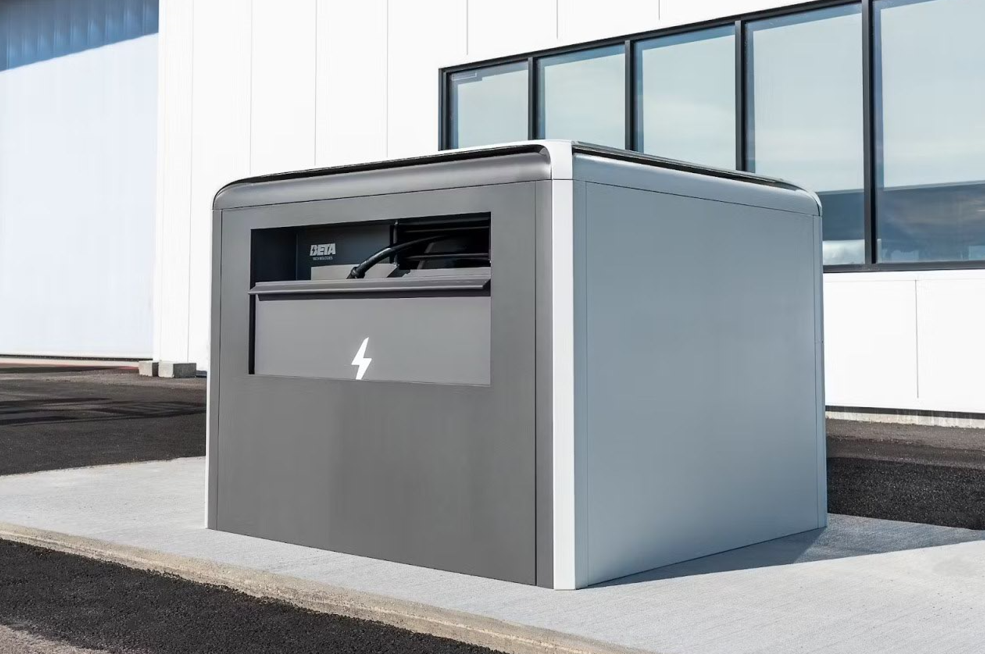
Beta Technologies has deployed Charge Cube stations to a host of locations, including Archer Aviation’s test facilities in California.
Beta Technologies has risen to claim the top ranking in the latest edition of the AAM Infrastructure Reality Index, reflecting recent progress made on rolling out its electric aircraft charging stations at more than a dozen locations along the U.S. East Coast.
Vermont-based Beta has already installed its Charge Cube systems–which utilize the Combined Charging System (CCS) standard commonly used in EVs–at 14 locations across the Eastern U.S., and development work is underway to install them at a further 55 sites along the U.S. Eastern and Gulf Coasts. Archer Aviation also plans to use the charging systems at its own facilities in California, part of an agreement signed between the two OEMs in November.
Already operational, Beta’s chargers served as way stations on a 16-day journey completed in November by the startup’s Alia conventional takeoff and landing (CTOL) electric aircraft from its Burlington, Vermont, headquarters through congested airspace over Boston, New York and Washington en route to Eglin AFB in Florida.
Sergio Cecutta, president of SMG Consulting and publisher of the AAM Infrastructure Reality Index, told the AAM Report that he is encouraged to see Beta already laying the groundwork for its cargo charging network. He added that charging stations can potentially be upgraded to larger vertiport facilities in the future.
“Beta is the one who has done the most work so far, and I’m sure they’re not building all these [charging stations] just for kicks or as a demonstration,” Cecutta says. “These are all part of the future routes that Beta will operate with UPS and other partners. We think they really have a major ace up their sleeve as an OEM building their own charging network, which they are incorporating directly into their flight testing. It’s a big advantage.”
Tied with Beta in first place is Italian startup Urban V, which is developing vertiport networks across Italy and parts of Europe. The company’s ranking improved in the latest index to reflect progress made toward certification of its first vertiport at Rome Fiumicino Airport. “They’ve been very quiet, not issuing press releases like some others, but they’re making progress,” Cecutta says.
The latest update of the AAM Infrastructure Reality Index was also notable for the inclusion of Atlantic Aviation in the No. 4 slot, marking the first time a fixed-base operator (FBO) had appeared on the index.
“We need to consider the fact that FBOs have an evergreen advantage, meaning they have everything ready to go,” Cecutta says. “Can they grow to the same size as some of these pure play vertiports as far as traffic? Probably not, but we also don’t think that big vertiports will be needed at the beginning, and I think it would be remiss not to consider the fact that these FBO chains already have a lot of existing infrastructure to begin deploying.”
As the new year begins, Cecutta offers a prediction that, excluding the sites being erected to facilitate urban air mobility (UAM) trips by Volocopter at the Paris Olympics next summer, just one vertiport will be certified and operational before year’s end–but with the caveat that it will only be available for cargo services, not passenger travel.
“When you look at regions like the Middle East, there is a lot of testing that is going on involving cargo and AAM [advanced air mobility], and it seems like this year that would be the first place where we might see some infrastructure popping up,” Cecutta says.
Ranked from first to last, and with a maximum possible score of 10, the latest edition of the AAM Infrastructure Reality Index features Beta (7.1) and Urban V (7.1) tied for first place, followed by Groupe ADP (7.0), Skyports (6.9), Atlantic Aviation (6.7), Urban-Air Port (6.5), Ferrovial (6.3), Munich Airport International (5.9), Bluenest (5.8), Volatus Infrastructure & Energy Solutions (5.6), Skyway (4.7), Skyscape (2.7), Kookiejar (2.4) and Skyportz (2.3).





